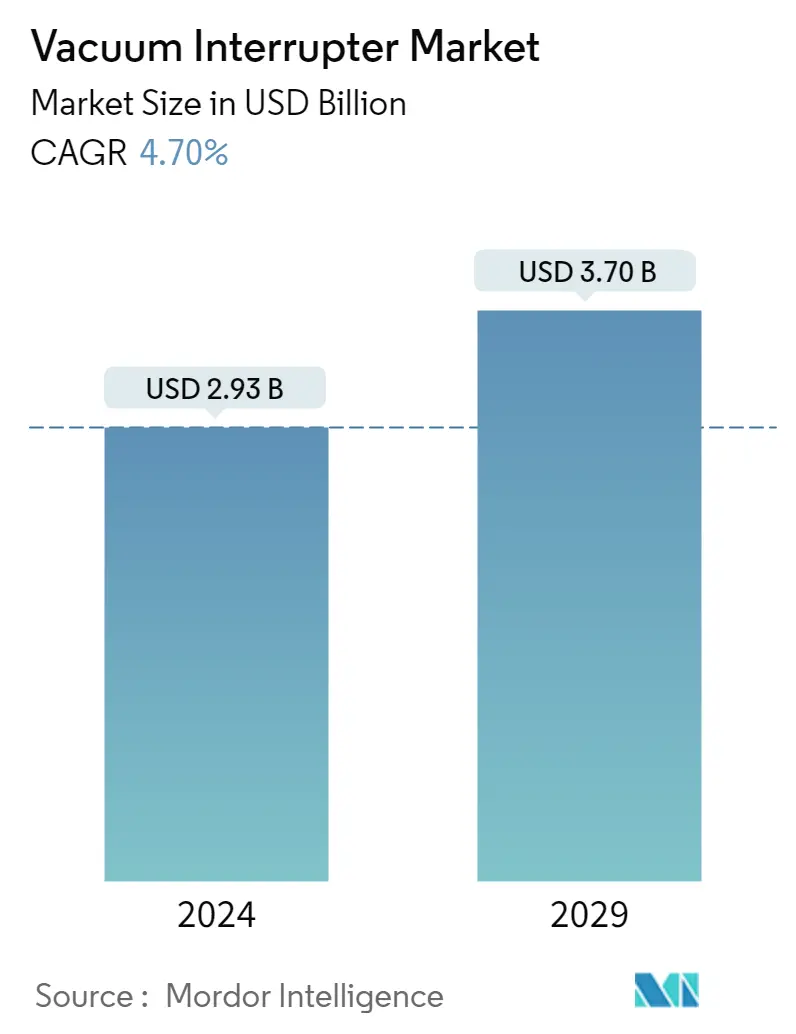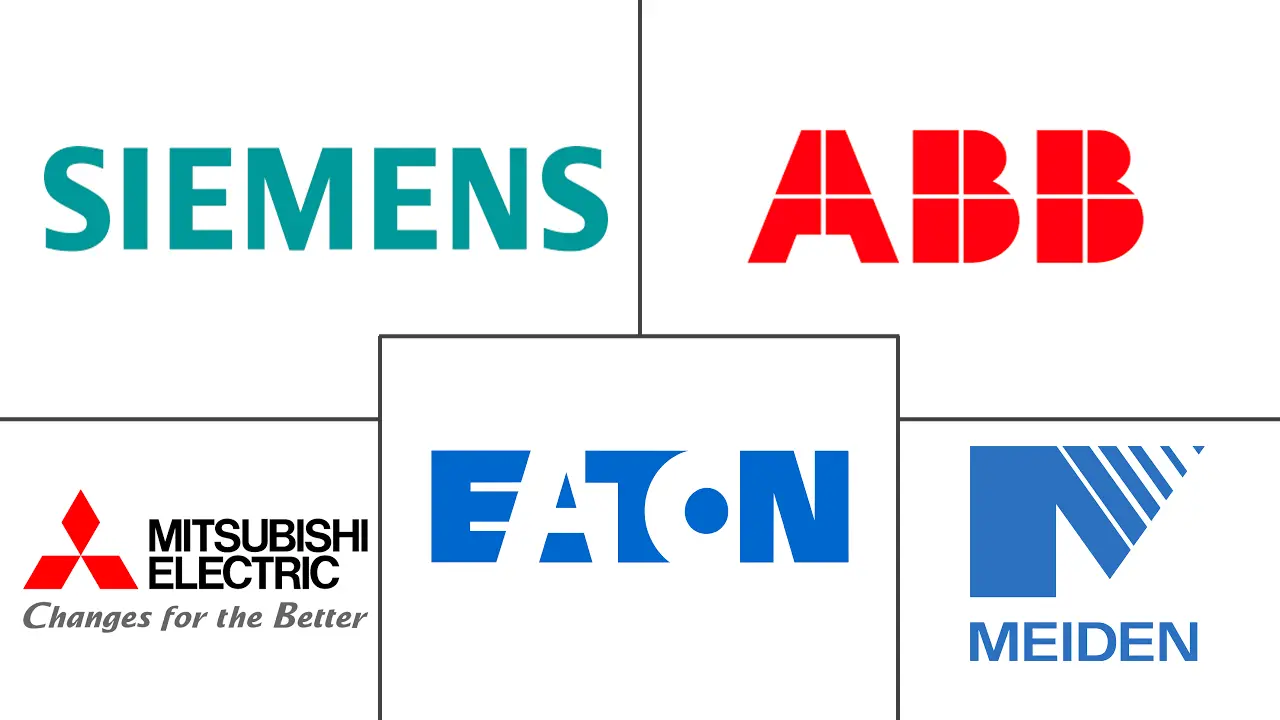Market Size of Vacuum Interrupter Industry

| Study Period | 2019 - 2029 |
| Market Size (2024) | USD 2.93 Billion |
| Market Size (2029) | USD 3.70 Billion |
| CAGR (2024 - 2029) | 4.70 % |
| Fastest Growing Market | Asia-Pacific |
| Largest Market | Asia Pacific |
Major Players
*Disclaimer: Major Players sorted in no particular order |
Vacuum Interrupter Market Analysis
The Vacuum Interrupter Market size is estimated at USD 2.93 billion in 2024, and is expected to reach USD 3.70 billion by 2029, growing at a CAGR of 4.70% during the forecast period (2024-2029).
- The increasing demand for safe and secure electrical distribution has led to the upgradation of outdated infrastructure, boosting the market demand for vacuum interrupters. Modernization work is also increasing in existing infrastructure due to technological advancements, with both developed and developing countries investing heavily in infrastructure upgrades to meet rising electricity demands. Additionally, environmental concerns and sustainability regulations in the energy sector are further driving the market growth.
- Vacuum interrupters are highly environmentally friendly, comprised of benign materials, and safe to handle during maintenance and disposal. However, the production of vacuum interrupters requires high technology, hindering the market growth. Transit damage or failure can cause a loss of vacuum, rendering the interrupter useless and impossible to repair on-site. Moreover, the high cost of vacuum interrupters for high-voltage applications further limits the market growth.
- Despite these challenges, the COVID-19 pandemic acting as a catalyst for Industry 4.0 developments led to innovations in vacuum interrupters, improving energy consumption with high-efficiency levels. Major global vendors are innovating their products, and electrical distributors are showcasing these new products on their websites to meet the growing need for vacuum interrupters.
Vacuum Interrupter Industry Segmentation
The vacuum interrupter is a switch that uses electrical contacts in a vacuum. It is a pair of separable contacts enclosed in a vacuum-tight envelope. The envelope is a ceramic material, with a metal end plate brazed to each end. The metal plates seal the ends and provide support for the parts inside. When the contacts are parted in the vacuum, as there is no gas in the bottle to ionize, the current flow is quickly extinguished.
The vacuum interrupter market is segmented by application (circuit breaker, contactor, recloser, load break switch) and geography (North America, Europe, Asia Pacific, Middle East & Africa, and Latin America). The market sizes and forecasts are provided in terms of value (USD) for all the above segments.
| By Application | |
| Circuit Breaker | |
| Contactor | |
| Recloser | |
| Load Break Switch | |
| Other Applications |
| By Geography | |
| North America | |
| Europe | |
| Asia Pacific | |
| Middle East and Africa | |
| Latin America |
Vacuum Interrupter Market Size Summary
The vacuum interrupter market is poised for steady growth, driven by the increasing need for safe and secure electrical distribution systems. This demand is largely fueled by the modernization of outdated infrastructure and the integration of advanced technologies in both developed and developing countries. The push towards smart grids, which enhance the efficiency and reliability of electricity delivery, is a significant factor in this market's expansion. These grids, capable of reducing power outages and improving service restoration, are seen as strategic investments by governments aiming for sustainable economic growth and carbon emission reductions. The vacuum interrupter technology plays a crucial role in these systems, offering automated controls for repetitive switching and fault protection, which are essential as more renewable energy sources are integrated into the grid.
Despite challenges such as high production costs and the need for advanced technology, the vacuum interrupter market is supported by innovations and strategic expansions by major global players. Companies like Eaton Corporation, Meidensha Corporation, Mitsubishi Electric Corporation, Siemens AG, and ABB are leading the charge with new product developments and certifications that enhance customer trust. The market's growth is further bolstered by initiatives like the US Department of Energy's Grid Modernization Initiative and significant investments in smart grid technologies. In the Asia-Pacific region, the focus on renewable energy projects and smart grid roadmaps is expected to drive demand for vacuum interrupters, particularly gas-insulated types, as countries seek to optimize power capacity and improve grid resilience.
Vacuum Interrupter Market Size - Table of Contents
-
1. MARKET INSIGHTS
-
1.1 Market Overview
-
1.2 Industry Value Chain Analysis
-
1.3 Industry Attractiveness - Porter's Five Forces Analysis
-
1.3.1 Bargaining Power of Buyers
-
1.3.2 Bargaining Power of Suppliers
-
1.3.3 Threat of New Entrants
-
1.3.4 Threat of Substitutes of Products
-
1.3.5 Intensity of Competitive Rivalry
-
-
1.4 Assessment of the Impact of COVID-19 on the Market
-
-
2. MARKET SEGMENTATION
-
2.1 By Application
-
2.1.1 Circuit Breaker
-
2.1.2 Contactor
-
2.1.3 Recloser
-
2.1.4 Load Break Switch
-
2.1.5 Other Applications
-
-
2.2 By Geography
-
2.2.1 North America
-
2.2.2 Europe
-
2.2.3 Asia Pacific
-
2.2.4 Middle East and Africa
-
2.2.5 Latin America
-
-
Vacuum Interrupter Market Size FAQs
How big is the Vacuum Interrupter Market?
The Vacuum Interrupter Market size is expected to reach USD 2.93 billion in 2024 and grow at a CAGR of 4.70% to reach USD 3.70 billion by 2029.
What is the current Vacuum Interrupter Market size?
In 2024, the Vacuum Interrupter Market size is expected to reach USD 2.93 billion.

